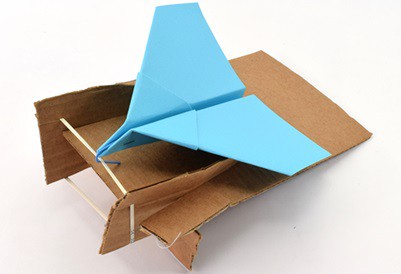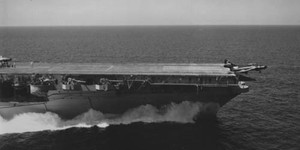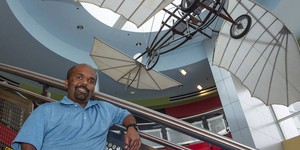Summary
Introduction
Here's a challenge: Try throwing a paper airplane by moving just your wrist (don't move your elbow or shoulder). It's hard, isn't it? How could you get a paper airplane to fly far if you can use only a short distance to launch it? Try this activity to find out!
Materials
- Paper
- Rubber bands
- Pen or pencil
- Paper clips
- Tape or stapler
- Construction materials to build a paper airplane launcher. You can use whatever materials you have available. Examples include cardboard, building toys such as LEGO® or K'NEX®, or wood.
- Open area to launch paper airplanes (without wind or strong drafts)
Prep Work
- To do this project, you will need to know how to build a basic paper airplane. Follow these paper airplane instructions if you need to learn how.
Instructions
- Build several paper airplanes to test. Because paper airplanes can get bent or destroyed easily, it's a good idea to build more than one. Ensure that they are all built the same for this activity.
- Tape or staple a paper clip to the nose of each paper airplane. The outer straight part of the paper clip should point backward parallel to the bottom of the plane, so it can serve as a hook to attach to the rubber band. There will be some pull on the hook, so make sure it's secure.
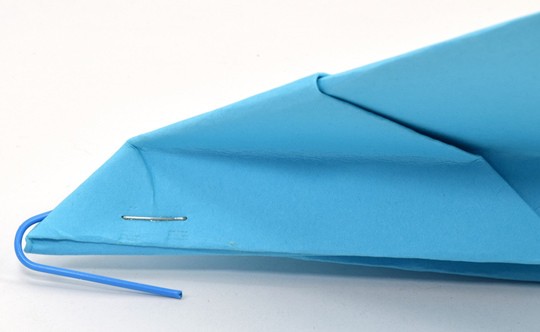 Image Credit: Ben Finio, Science Buddies / Science Buddies
Image Credit: Ben Finio, Science Buddies / Science Buddies
- Practice throwing your paper airplane using your entire arm. How far can you throw your plane? How much do you move your arm when you throw it?
- Now try to throw your airplane only using your wrist. Keep your shoulder and elbow still. How far can you throw the plane now?
- Next try launching your airplane using a very simple "catapult." Hook one end of a rubber band around the end of a pencil (such as around the metal ring by the eraser). Hook the paper clip on the nose of a plane around the other end of the rubber band, and pull it back to stretch the rubber band. Aim the plane forward and release. How far does the plane go now? How far did you have to stretch the rubber band compared to how far you moved your arm or wrist?
- Now use the engineering design process to build a more permanent launcher for your airplane. Think about the criteria for your design. You will need to build a device to support the rubber band. It will need to be strong enough that it does not collapse when you pull back on the rubber band. You will also need to make sure the paper airplane does not get caught or snagged on the device when you launch it. Draw a few sketches of your design ideas, and pick one to build.
- Build a prototype of your design. You might find that things don't fit together like you thought they would, and you need to change your design. That's okay! This picture shows three different designs built with different materials.
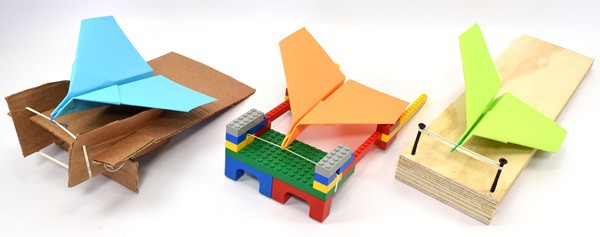 Image Credit: Ben Finio, Science Buddies / Science Buddies
Image Credit: Ben Finio, Science Buddies / Science Buddies
- Test your airplane launcher. It probably won't work perfectly on the first try. What changes can you make to your design to make it better?
- Keep improving your launcher and testing it again (and, if necessary, again). This process is called iteration, and designers and engineers use it often in their work. How does the plane's flight distance compare to when you threw with your arm or with your wrist?
What Happened?
You probably found that it was very difficult to throw your paper airplane very far when using only your wrist. Your wrist has a much smaller range of motion than your entire arm, and it's difficult to get the airplane going fast enough for a long flight. A rubber band, however, can store quite a bit of energy in a relatively small distance when it is stretched. A launcher built with a rubber band can get the paper airplane going fast over a much shorter distance, allowing you to launch it much farther than you can with just your wrist—possibly even farther than you could with your entire arm!
Digging Deeper
In order to take off, an airplane has to generate enough lift (upward force due to air pushing on the plane) to overcome its weight (downward force due to gravity). The faster an airplane goes, the more lift it generates. This is why airport runways are usually very long (sometimes longer than a mile): because planes need a lot of space to gain enough speed to take off. They also need a lot of space to land safely and slow down from such high speeds.
Aircraft carriers are large ships with runways on them that allow aircraft to take off and land in the open ocean. Although aircraft carriers are huge compared with most other ships, they are very small compared with land-based airports and runways. The largest aircraft carrier is just longer than 1,000 feet, which is still less than a quarter of a mile. Airplanes can't gain enough speed to take off on their own over such a short distance, so they get an extra boost from a type of catapult (not the big wooden kind you might imagine flinging stones at castle walls). This catapult provides extra energy from a source such as compressed air or electromagnets to help the plane gain extra speed. The catapult hooks on to the plane and helps it accelerate over a much shorter distance so that it can get enough speed and lift to take off.
You don't need any compressed air or electromagnets to build your own airplane catapult, however. In this project you built one using a rubber band. It stored potential energy, which gave extra kinetic energy (motion energy) to the paper airplane—even over a short distance. It's much more effective than just using your wrist!
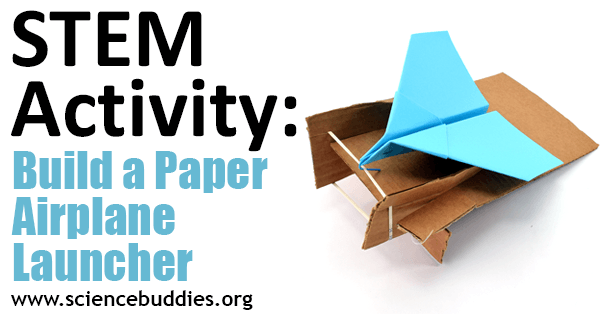 Image Credit: Science Buddies
Image Credit: Science Buddies
Ask an Expert
For Further Exploration
- How does the angle at which you launch the plane affect its flight distance?
- Try using different lengths and thicknesses of rubber bands. Do some work better than others? Why do you think that is?
Related Resources
Project Ideas
Lesson Plans
- MS-PS3-2. Develop a model to describe that when the arrangement of objects interacting at a distance changes, different amounts of potential energy are stored in the system.
- MS-ETS1-4. Develop a model to generate data for iterative testing and modification of a proposed object, tool, or process such that an optimal design can be achieved.


